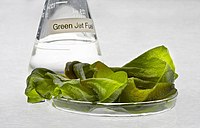
Photo from wikipedia
Ethanol-assisted liquefaction followed by a hydrotreating process has been applied to the microalgal biomass of Chlamydomonas. The intent of the research was to develop process technology to convert microalgae into… Click to show full abstract
Ethanol-assisted liquefaction followed by a hydrotreating process has been applied to the microalgal biomass of Chlamydomonas. The intent of the research was to develop process technology to convert microalgae into drop-in fuels. The operation conditions of the ethanol-assisted liquefaction were optimized using the following variables: reaction temperatures (200–290 °C), ethanol concentration (10–90 vol. %), residence time (0.5–2 h), and the catalyst (SO42–/ZrO2). The application of a higher ethanol concentration and the solid acid enhanced extraction of algal lipids and transesterification. The highest liquid yield of 93.7% for catalytic liquefaction was obtained under the reaction conditions of (290 °C, 90 vol. % ethanol, and 0.5 h). Hydrotreating of the liquid products generated via liquefying microalgae was conducted over a Mo2C/Biochar catalyst at 340 °C and 3.44 MPa hydrogen. The obtained products contained predominantly hydrocarbon molecules falling into the diesel range.
Journal Title: Energy & Fuels
Year Published: 2017
Link to full text (if available)
Share on Social Media: Sign Up to like & get
recommendations!